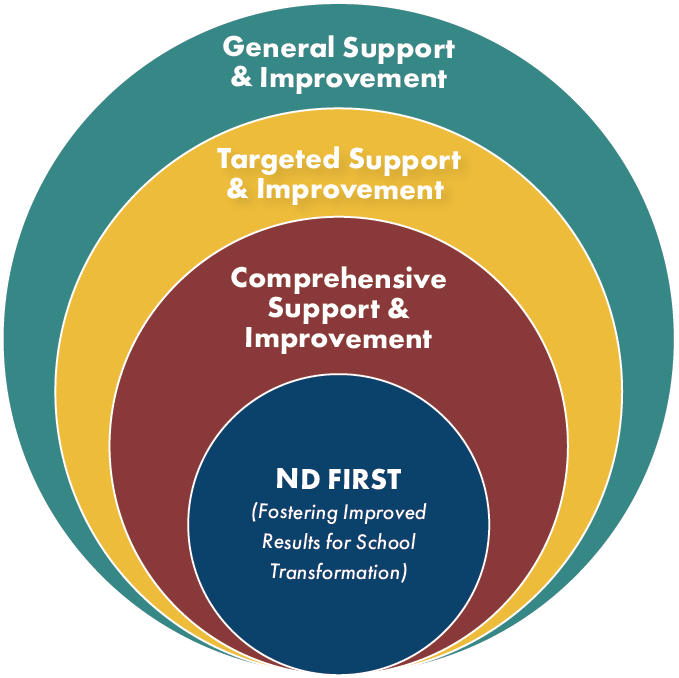The purpose of our accountability system is to provide statewide responsibility of all stakeholders to pursue our North Dakota vision. Through this accountability framework, North Dakota will:
- Provide transparency and public reporting of key performance and improvement indicators for all schools, districts, and the state;
- Ensure all schools and districts are engaged in a process of continuous improvement;
- Identify when and where desired results are not being achieved and prioritize which schools are most in need of support; and
- Allocate resources and support services, increase oversight and engagement, and elevate accountability for those schools most in need of support.
North Dakota’s accountability system provides a framework upon which we consistently, continuously, and holistically evaluate the ability of our state’s education system to achieve desired outcomes. North Dakota's plan focuses around a continuous improvement model*. North Dakota’s model allows multiple indicators to be used when outlining a school’s measure of quality. In addition to student achievement, Choice Ready, graduation rate, and EL achievement, North Dakota applies a composite growth model within its accountability system under ESSA. Any academic achievement goals, either long-term or interim, also apply to composite and subgroup academic achievement for schools, districts, and the state per the accountability indicators displayed below:
Currently, North Dakota uses a school's strategy map to illustrate evidence of continuous improvement for all public schools. All schools are also encouraged to implement improvement science, which is an evidence-based strategy that can assist schools in reaching their school improvement goals. Schools can utilize the School Renewal Guide as a resource. When schools are found to be underperforming on accountability measures, some schools will be identified for targeted support and improvement or comprehensive support and improvement. To learn more about the North Dakota Accountability System, click through the Accountability Overview or watch a webinar.

*Disclaimer: Due to a USED waiver issued in March 2020 as a result of the pandemic, states were allowed to pause accountability and the use of 2019-2020 and 2020-2021 data for identification purposes. Therefore, North Dakota is unable to fulfill the part of its ESSA plan that requires “three years of consecutive underperformance” when selecting schools for TSI/CSI. However, the USED required states to resume accountability in 2021-2022, and states were instructed to run accountability to ensure that schools that are underperforming compared to other schools in the state receive the support and resources needed to make improvements. The NDDPI utilized data from 2021-2022, 2022-2023, and 2023-2024 to determine TSI identification and to rank schools based on three years of underperformance and with subgroups performing below the highest-performing CSI school. The NDDPI will be able to fully implement its ESSA plan as written in the fall of 2025 for both TSI and CSI schools.
Q & A
Q: Why do I have zero points in certain sections of the Accountability Index on the SLDS , but I have percentages? For example, I have a 100% graduation rate, but zero points. Shouldn’t I get points as well?
A: In this example there were seven students who graduated out of a total of seven. In the SLDS you will see percentage data and no points awarded because your “n” size is smaller than 10 students. This “n” size is a small subgroup whose data can easily be matched with a student if a person would research more deeply. Thus, “n” sizes keep students safe and unidentifiable, and you will not see this information released. In the example that began this paragraph the “n” size of seven was too small to report data.
The points that would have been given in this section of the Index is equitably distributed to other factors in the Index making other accountability factors worth more points. In addition, this information will not be published on the Insights dashboard.
Q: Why does the graph show 0% assessment participation when I select grade 11 participation data?
A: To see the actual high school assessment participation rate, you must choose grade 10 for districts using the NDSA for high school accountability or grade 11 for districts using the ACT for high school accountability. Selection of a grade that does not take an assessment for accountability will display a graph showing a zero-participation rate.
Q: Why can’t data be published for students in a subgroup with an “n” size small then 10?
A: To protect student privacy, any data elements involving fewer than 10 students are not displayed. Additionally, information involving 10 or more students may be displayed in ranges to avoid potential identification of students.
Accountability Calendar
Under ESSA, State education departments are required to annually create an accountability report for every public school in the state.
The school accountability reports outline how schools are performing on the accountability elements North Dakota selected within the ESSA plan.
School accountability reports are released in mid-August. Listed below are the report deadlines, key dates, and links to additional information on the NDDPI website.
| Student Engagement Survey | Survey Window: January - February |
|---|---|
| Assessment Test Windows | North Dakota Department of Public Instruction | |
| Graduation Report | Deadline to submit report: June 30 |
| Choice Ready Report | Deadline to submit report: June 30 |
Resources
- Insights Public Release 2025 Slide Deck
- Insights Public Release 2025 Webinar
- Accountability Release Memo 2025
- Accountability Report Review and Data Overview
- School Accountability Calculation Guide
- School Accountability - Steps for Submitting Questions or Appeals
- Accountability Validation User Guide
- Accountability Validation User Stories
- ND School Improvement Process Map
- Elementary PowerPoint Template
- High School PowerPoint Template
- Sample Parent Letter
- Sample Website Notification
- PK-12 Strategic Vision Framework/ESSA Accountability Crosswalk
- North Dakota Accountability System Visual
- North Dakota School Improvement Visual
- How to use K12 Reporting and Analytics for Accountability
- School Improvement and Related Provisions – USED Non-Regulatory Guidance
